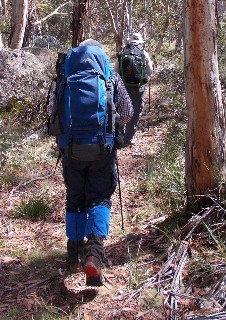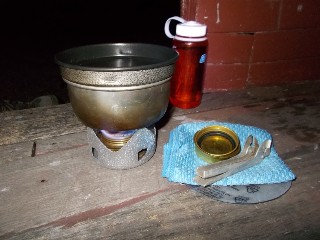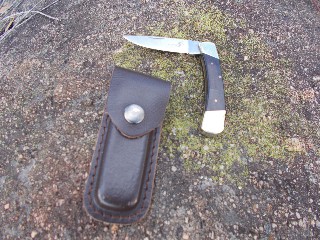
L-R: Carrying a Mont Flyte Rucksack on Bibbenluke Ridge in the Budawangs, my old trusty Macpac Ascent on the Hume & Hovell Walking Track and for two day hikes, my new Mountain Designs Explorer 65 on the Settlers Track in Namadgi NP
Use this as a guide to organise your own equipment list, though those experienced in hiking trips would not need to use this list, it does open up ideas for suggestions.
For longer hikes - I utilise smaller and lighter items to help make way for extra food and clothing if need be.
This list also includes what I would take for my daily food requirements which changes all the time - again this is of a personal taste and you can make your own list up for whatever suits you
The author takes no responsibility for anyone who gains mishap from using this list - most of it is basically commonsense. I have experienced many successful hiking trips using the list below
ESSENTIAL ITEMS
Rucksack (Preferably 50-80 litre
capacity with a decent weight bearing harness system and a strong hip belt
- I prefer to use either a Macpac
or Mont)
Rucksack liner (Sea
To Summit make great waterproof liners, though 1-2 large strong garbage
bags can do the job)
Steripen or Water Purifyer (Mine
is a Katadyn and is great for
filtering slow moving water)
Hydration Bag (If in an area where
there are plenty of creeks to cross I'd take a 1 litre bag otherwise a
3 litre is a must)
Boots (Whatever keeps your feet
comfortable, protected and dry)
Trekking Poles (They can take the
load off your knees and ankles, increase durability and aid travel on uneven
ground, assist water crossings and steep descents. A pair of two sticks
are recommended - I use Leki
Poles)

L-R: Carrying a Mont Flyte Rucksack on Bibbenluke Ridge in the Budawangs, my old trusty Macpac Ascent on the Hume & Hovell Walking Track and for two day hikes, my new Mountain Designs Explorer 65 on the Settlers Track in Namadgi NP
SLEEPING
Tent,fly,poles & pegs (A lightweight
1 or 2 person capacity tent is essential. My main tents are now either
a Hilleberg Atko or Niak)
Sleeping Bag & Stuff Sack (A
good 3 season Down filled Bag is perfect. I use a Mont)
Silk Liner (Protects your expensive
sleeping bag from dirt and odors)
Thermarest Self-Inflating Sleeping Mat (Used
as a comfortable and insulating mattress)
Left to right: My old trusty Macpac Microlight Tent which I've owned since the early 2000's and used entirely on the 2018 HHWT, the Granddaddy of all my tents, my old Adventure Designs Fastback which still gets good use on some of my walks despite its age, the Marmot Tungsten, great for short walks and little gear though the vestibule is generous, and my latest additions, the Hilleberg Atko, great for four season hiking and easy to pitch, and the Hilleberg Niak, three season but with that extra room without the extra weight.
Some of my sleeping gear set up inside one of my Hilleberg tents (a Mont Hydronaut XT Highland sleeping bag with Sea To Summit Aeros inflatable pillow)
CLOTHING
1x Thermal T-shirt (Perfect for
those cold nights - a Merino blend is my preference)
2x Shirts (Long Sleeve) (A lighweight,
moisture wicking shirt is recommended - I like the Exofficio brand - sold
by Paddy Pallin in Australia)
1x Thermal Pants (Used for sleeping
in - any polypropilene will do and keep you warm)
2x Long Trousers (As with the shirts.
I prefer Mont brand, it has a built-in
belt and you can choose between full length or zip off legs to make shorts)
2x Thick socks (Most wool blend
will do but I preder the 'Smart Wool' brand)
2x Briefs (Anything but cotton -
Exofficio make a great product that wick away the sweat and these days
there is a range of bamboo style underwear to prevent chafing)
Beanie (Fleece or wool will do)
1x Down Jacket (The down jackets
can be compressed into a small stuff sack where fleece will take up room
in your rucksack. I have an assortment of hooded, sleveless and long sleeve
down jackets to choose from depending on conditions and rucksack space
available)
This down jacket has kept me very warm around campsite where campfires are not permitted
Gore-tex Raincoat (A must on any
trip. If keeping to a trail a poncho can suffice)
Wet Weather Pants (Optional) (Will
keep your legs dry, but are they worth the extra space taken in the rucksack?)
Cabin Boots or Sandals (Perfect
for around camp when you just need to get out of those boots after a hard
day's walking sandals can be worn for river crossings)
Gloves (Preferably fleece or wool
to keep your fingers warm)
Sun Hat & Sunglasses

Good wet weather gear is essential (Overland Track Tasmania)
COOKING / EATING
Trangia Stove & Pot set (Come
in a range of sizes and uses methylated spirits for fuel. Trangia
is perfect for what I like to cook but just lately I've been very impressed
with my Optimus Crux Stove and Terra WE Pot Set)
Fuel & Bottle (Methylated Spirits
kept in a steel leak proof bottle for the Trangia)
Eating Irons (Any plastic or aluminium
knife, fork & spoon set for eating. I use a titranium fold-up spork
made by Sea To Summit)
Mug (Any plastic 'Decor' type mug
will suffice but Sea To Summit now have the "X" brand of collapsible cups
and bowls)
Water Bag (4 Litre Wine Bladder) (I
use these to collect water from nearby creeks to be used for cooking at
camp)
Matches (There are many types that
include windproof and waterproof)
Pot Scourer (Sponge with nylon scour
pad - perfect for cleaning utensils. A small plastic bottle of detergent
can also be carried)

A selection of cookwear I use when on hiking trips. L-R: My Trusty Trangia stove & pot set, The Mini Trangia and my Optimus Crux Stove & Terra WE Pot
ACCESSORIES
Caplamp & Batteries (A great
range of hands free models are available and LED technology means you only
need 3 or 4 batteries on a trip - I use Petzl)
Swiss Army Knife (A multi purpose
tool that can have many uses - Victorinox,
Leatherman and Wenger are the best brands)
Rag for wiping tent (Can be attached
to the outside of your rucksack. I use it to wipe off the condensation
when packing up)
Maps & Map Case (A map case
helps keep your maps dry and clean)
GPS/Compass & Whistle (I take
both a GPS and a compass. The whistle can come in very handy)
Rubbish Bags (Shopping style plastic
bags for rubbish, food and other items kept in your rucksack, like spare
clothing)
Dry Bags (A great alternative to
plastic shopping bags - Sea To
Summit have a great range)
Other Equipment: L-R: My old trusty Scarpa leather boots after 5 days in the Budawangs, my new Asolo boots which give great toe room and a strong durable sole but for multi day hikes I now trust my Keen Gypsum II boots which give plenty of width for swelling feet due to excess pack weight and long distances walked

Two of the knives I take with me on walks. (Left) a Victorinox Swiss Army style multi-use knife which I use on my multi day walks and (right) a Mustang single blade knife & pouch, perfect for day walks followed by my new (2020) Mountain Designs Trekking Poles which will be replacing my long suffering Leki poles which had served me so well over counless multi day and day walks during the previous 13 years
PERSONAL GEAR
Toilet Roll & Medi-Wipes/Sanitising Gel (Essential
items for those urgent needs)
Dental Kit (Toothbrush, Mouthwash
etc)
First Aid Kit (The contents in this
vary from person to person depending on requirements. Check any hiking
book for more details)
Emergency Kit (Optional) (You can
carry a small mirror, matches, needle & thread etc etc)
L-R: Platypus collapsable water container, (more photographs coming soon)
FOOD (This is what I would take on a trip multiplied by
the number of days required)
Freeze Dry Meals (Just add boiling
water, reseal and wait. Can be expensive - eat from the packet - see below
for list of 2 brands I use)
Cup-A-Soups (Many brands and varieties
can be found in your local supermarket aisle)
Breakfast (Cereal in small ziplock
bags or Quick Oats are easy to prepare - Kelloggs Variety are handy, lightweight
and take up little space)
Tortillas (Flat breads that sit
protected in the side of your rucksack)
Packet Salmon or Tuna (In sealed
sachets found in your local supermarket)
Salami (Can keep for many days if
kept in an airtight bag)
Cheese (As above - or use processed
or cheese sticks)
Trail Snacks (Nuts/Sweets/Chocolate
bars - to eat on the go or at occasional stops)
Coffee/Tea (For that brew up - don't
forget your powdered milk and sugar if you prefer them)
L-R: My Katadyn Guide water purifyer which doesn't get
used too often these days as I have other lighter alternatives. A Kti Personal
Locator Beacon. My new Thermacell mosquito repellant system and my Garmin
GPSMap 64 - I never thought anything would replace my Magellan 310.
Most equipment commented on here can be purchased from Paddy Pallin in Australia, though Mont also have an excellent range of quality Australian made equipment
A great website to visit for equipment reviews and ideas is Trailspace.com